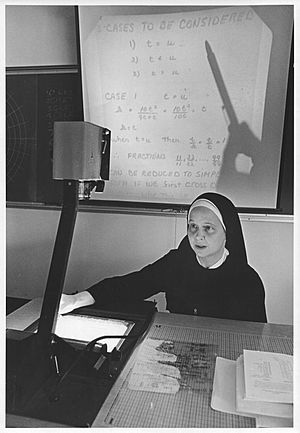Harriet Padberg facts for kids
Quick facts for kids
Sr. Harriet Padberg
|
|
|---|---|

Padberg teaching at Maryville University
|
|
| Born | 13 November 1922 |
| Died | 2 January 2014 (aged 91) |
| Alma mater | Maryville College of the Sacred Heart, now Maryville University |
| Scientific career | |
| Fields | Music, Mathematics |
| Thesis | Computer Composed Canon and Free Fugue |
Harriet Padberg was an amazing American woman. She was a mathematician, a composer, and a music therapist. She was also a Catholic religious sister, which means she dedicated her life to God and helping others.
Harriet Padberg was a leader in music therapy, which uses music to help people feel better. She also made important contributions to creating music with computers. Her paper, Computer-Composed Canon and Free Fugue, was part of her studies at Saint Louis University in 1964. She taught for over 35 years before she retired and focused on music therapy.
Harriet Padberg's Early Life and Education
Harriet Padberg went to the Academy of the Sacred Heart in St. Louis, Missouri. She won a scholarship to Maryville College, which is now Maryville University. In 1943, she earned her first degree in Math and Music.
Soon after, she joined the Society of the Sacred Heart. This is a group of Catholic religious sisters. She taught for a short time at different Sacred Heart schools, including one in Grand Coteau, Louisiana.
In 1948, she returned to teach at the Academy of the Sacred Heart in St. Charles. At the same time, she earned her master's degree in Music and Organ. She got this degree from the College Conservatory of Music in 1949. In 1951, Padberg became a fully professed Sister of the Sacred Heart.
Sister Padberg went back to Grand Coteau in 1951. She taught there for four years in both high school and college. Then, she taught at Maryville College for a year. After that, she spent a year at the Academy of the Sacred Heart in St. Louis. Finally, she returned to Maryville College, where she taught for 35 years.
In 1959, Padberg earned a Ph.D. in Math and another Master of Arts degree from St. Louis University. She also completed an internship in music therapy.
Making Music with Computers
In 1964, Sister Padberg wrote her important paper, Computer Composed Canon and Free Fugue. This was probably the first paper ever written about using computers to create music. Her computer program was special because it used a set of rules, called an algorithm, to make music. Other programs at the time often just made random sounds.
Her program could read a string of up to 160 letters or characters. It then turned each letter into a specific musical note. It also divided the music into sections to figure out the rhythm. The program would create a main melody line. Then, it would change and move this melody to create a full song. The music was printed out on special punch cards. These cards showed the melody and the rhythm.
Sister Padberg wrote two computer programs using a language called FORTRAN. Both programs were included in her paper. The first program was for the IBM 1620 computer. Because of the computer's limits, it could only make music with one voice or part.
Later, she rewrote the program for the IBM 7072 computer. This new program was much better! It could create music with two to four voices. It could also make more complex songs called "free fugues."
Padberg's work with computer music showed her interest in a style of music called Serialism. This style was popular in the 20th century. She even made a song based on the name of the famous composer Johann Sebastian Bach. She called it the "J. S. Bach Fugue." She also created a "Patriotic Fugue" using words from John F. Kennedy's famous speech: "Ask not what your country can do for you; ask what you can do for your country."
Helping People with Music Therapy
After finishing her studies, Sister Padberg learned more about Music Therapy. She studied how music could help children with special needs.
In 1973, she started the Music Therapy program at Maryville University. Today, this program is recognized by important music organizations. Padberg also gave talks at music therapy conferences. She was an active member of the National Association of Music Therapy. She retired in 1992, but she kept practicing music therapy and teaching music until 2012.

